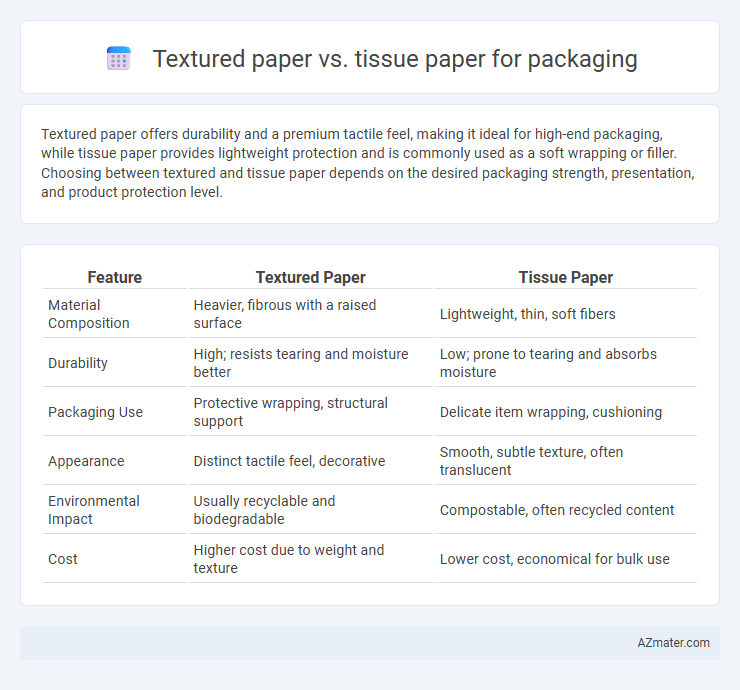Textured paper offers durability and a premium tactile feel, making it ideal for high-end packaging, while tissue paper provides lightweight protection and is commonly used as a soft wrapping or filler. Choosing between textured and tissue paper depends on the desired packaging strength, presentation, and product protection level.
Table of Comparison
| Feature | Textured Paper | Tissue Paper |
|---|---|---|
| Material Composition | Heavier, fibrous with a raised surface | Lightweight, thin, soft fibers |
| Durability | High; resists tearing and moisture better | Low; prone to tearing and absorbs moisture |
| Packaging Use | Protective wrapping, structural support | Delicate item wrapping, cushioning |
| Appearance | Distinct tactile feel, decorative | Smooth, subtle texture, often translucent |
| Environmental Impact | Usually recyclable and biodegradable | Compostable, often recycled content |
| Cost | Higher cost due to weight and texture | Lower cost, economical for bulk use |
Introduction to Packaging Materials
Textured paper offers a durable and visually appealing option for packaging, providing enhanced grip and a premium feel suitable for luxury products and retail presentation. Tissue paper, known for its lightweight and soft qualities, excels in delicate item wrapping and layering to protect against scratches and dust. Both materials play essential roles in packaging, with textured paper emphasizing strength and aesthetics, while tissue paper focuses on cushioning and moisture resistance.
What is Textured Paper?
Textured paper is a type of specialty paper characterized by a raised or embossed surface that adds a tactile dimension to packaging, enhancing the unboxing experience and brand perception. Unlike tissue paper, which is thin, soft, and used primarily for wrapping or protecting delicate items, textured paper provides durability and a premium aesthetic with patterns such as linen, felt, or woven looks. This makes textured paper ideal for product packaging where visual appeal and structural integrity are essential.
What is Tissue Paper?
Tissue paper is a lightweight, thin, and soft paper commonly used for wrapping delicate items and providing cushioning in packaging. It is typically made from recycled fibers or virgin pulp, offering breathability and protection while adding a decorative touch. Tissue paper's versatility and cost-effectiveness make it ideal for gift wrapping, product presentation, and void filling in shipping boxes.
Key Differences Between Textured and Tissue Paper
Textured paper features a raised or embossed surface that enhances grip and visual appeal, making it ideal for premium packaging and branding. Tissue paper is thin, soft, and translucent, commonly used for wrapping delicate items or adding a protective cushioning layer in packaging. The primary difference lies in texture and thickness: textured paper offers durability and aesthetic richness, while tissue paper prioritizes lightweight protection and flexibility.
Durability and Strength Comparison
Textured paper offers higher durability and tear resistance, making it ideal for packaging items that require sturdy protection during transit. Tissue paper, while softer and more lightweight, lacks the tensile strength needed to shield products from impact or heavy handling but excels in delicate wrapping and cushioning. Choosing textured paper enhances packaging robustness, whereas tissue paper prioritizes gentle coverage and aesthetic appeal.
Aesthetic Appeal and Branding Potential
Textured paper enhances packaging with a tactile and visually rich surface, elevating brand perception through luxury and sophistication. Tissue paper offers a delicate, translucent quality that creates an elegant unboxing experience, reinforcing brand care and attention to detail. Both materials contribute uniquely to aesthetic appeal, with textured paper emphasizing durability and premium feel, while tissue paper highlights softness and subtlety in branding presentations.
Cost Analysis: Textured Paper vs Tissue Paper
Textured paper typically incurs higher production costs due to its specialized surface treatment and durability, which can result in increased packaging expenses compared to tissue paper. Tissue paper offers a more cost-effective solution with lower material and manufacturing costs, making it ideal for bulk packaging and lightweight applications. Evaluating the total cost of use involves considering factors such as printing quality, protection level, and brand presentation alongside raw material expenses.
Sustainability and Eco-Friendliness
Textured paper, often made from recycled fibers, offers enhanced durability and biodegradability, making it a sustainable choice for eco-conscious packaging. Tissue paper, while lightweight and biodegradable, typically uses fewer resources in production but may lack the robustness needed for heavy packaging applications. Both materials support environmental goals, yet textured paper's recyclability and compostability give it a slight advantage in long-term sustainability.
Ideal Uses for Textured Paper in Packaging
Textured paper is ideal for premium packaging due to its durability, tactile appeal, and ability to enhance brand perception through a high-quality finish. It is commonly used for luxury product boxes, gift wraps, and specialty bags where a sophisticated and visually striking presentation is essential. Unlike tissue paper, which is lightweight and primarily used for cushioning and wrapping delicate items, textured paper provides structural integrity and serves as a stylish outer layer that protects and showcases the product effectively.
Best Applications for Tissue Paper in Packaging
Tissue paper excels in packaging applications that require lightweight, delicate protection, making it ideal for wrapping fragile items like glassware, cosmetics, and luxury apparel. Its soft, thin composition provides cushioning and prevents scratches while offering breathability, which is crucial for preserving the quality of fresh produce or delicate textiles. Tissue paper is also favored for gift wrapping due to its decorative appeal and ability to add a luxurious touch without bulky weight.

Infographic: Textured paper vs Tissue paper for Packaging
 azmater.com
azmater.com